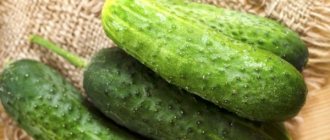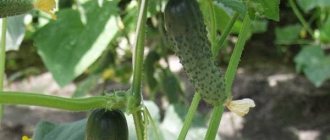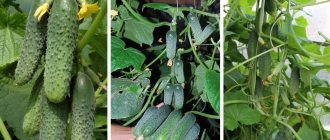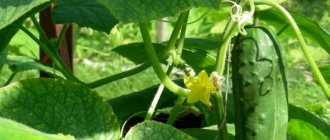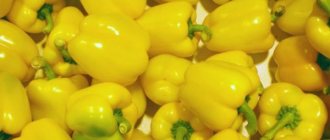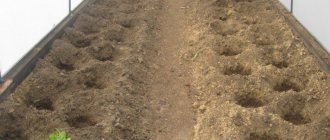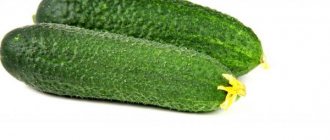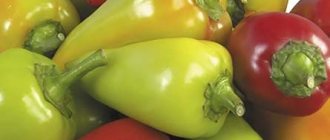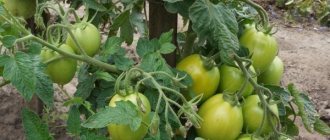Productivity and marketability are perfectly combined in the Primadonna f1 cucumber. Growing a high-yielding parthenocarpic hybrid is nothing simpler. Cucumber rarely gets sick and can withstand bad weather.
| Landing location | Ripening time | Mode of application | Fruit length | Group | Fruit smoothness | Pollination method |
| Universal | Early ripening (35-45 days) | Universal | Short (gherkins) - less than 10 cm | Hybrid | Highly lumpy | Parthenocarpic |
Description of the variety
Plant of the Primadonna variety is female type, vigorous and highly climbing, yield up to 28 kg/m2. It is grown in open ground in different areas:
- Tomsk;
- Novosibirsk;
- Omsk;
- Tyumen;
- Kemerovo.
The variety has a number of features:
- the shape of the fruit is elongated, slightly rounded, with a narrowed tip;
- the size of the cucumber does not exceed 12 cm;
- the seeds inside are small;
- average cucumber weight – 100 g;
- the skin of the fruit is dark green, lighter at the edges;
- lack of bitterness.
The advantages include:
- early ripening (about 40 days from the moment of the first fruit);
- fetal growth even in the absence of unstable temperatures;
- vigorous stem growth;
- does not require insects for pollination;
- require minimal care.
In terms of characteristics, the Primadonna variety differs significantly from its competitors. It grows tall, about 175-180 cm. The trunk is thin and flexible, but has many branches that spread widely, 90 cm in length.
Note! The crown of the plant is dense and has a dark green color, like the leaves located on the trunk. The ovaries are on average 4 units, but sometimes grow to 7-8.
The fruits form massive clusters. Ribbed, dense green skin - this is what a Primadonna cucumber should look like. A characteristic and distinctive feature of the variety is the absence of bitterness in the entire fruit. The taste is rich, the grains are small, the flesh is soft.
Cucumber Athos
Atos cucumbers are a hybrid variety recently bred by Russian breeders. The seeds have recently appeared on the market; the species is intended for cultivation in open ground and in greenhouses. The characteristics of the hybrid, its qualities and properties, reviews from summer residents and vegetable growers make it possible to classify it as promising for cultivation not only in the south.
Characteristic properties of the variety
Atos cucumber is an early variety with high seed germination; the first harvest is harvested 35-40 days after germination. The bush grows more than two meters in height, the variety is frost- and heat-resistant, and tolerates a lack of moisture.
A high-yielding hybrid, up to 20 fruits ripen on one bush, up to 12 kilograms of cucumbers are harvested from one square meter.
The fruits are up to 10 cm long and 2 cm in diameter. Weight varies from 70 to 100 g. The size of the fruit allows them to be collected at the pickle stage, up to 5 centimeters, and at the gherkin stage, up to 9 centimeters.
Note! The dense arrangement of small tubercles and thin skin, combined with the dense and durable pulp of the cucumber, make it suitable for pickling and pickling. The hybrid is pollinated without the participation of insects, fruiting occurs in a bouquet of 5 to 7 flowers
The hybrid is pollinated without the participation of insects, fruiting occurs in a bouquet of 5 to 7 flowers.
Growing cucumbers
Atos hybrids of domestic selection grow well both in greenhouses and in open ground. In Russia, cucumbers grow in open ground in the southern regions; for the middle zone, film coverings are needed. It is recommended to plant the seeds under the film by cutting holes and planting 2-3 seeds there to a depth of 2 cm.
Planting is possible with seeds or seedlings.
- Seeds are planted to a depth of 2 cm, the optimal temperature when planting seeds is 25-30 degrees, but they germinate even at 13 degrees. Seed germination depends on soil temperature; if planted in soil heated to 20 degrees, seedlings will appear in 5 days. At a soil temperature of 18 degrees, seedlings will appear in 10 days. The optimal temperatures for growing are 22 degrees during the day and 19-20 degrees at night.
- Cucumber seedlings are planted in the ground when consistently warm weather sets in at a distance of 1/2 m from each other.
Planting care:
- Soil cultivation, regular loosening and weeding every 10 days.
- Watering plants with warm water (20 degrees) in the evening or morning every day, sparingly, to avoid the formation of puddles, can cause rotting of the roots.
- Regular removal of side shoots above the fourth leaf.
- Tying to trellises.
- Periodic feeding, 3 times per season.
Loosening should be done immediately after watering, this improves growth, protects against pests, fungal infections, and gets rid of insects living in the weeds.
Advantages of the variety
For the Atos variety, a varietal technology for growing in open ground for large areas has been developed, which allows farmers to collect up to 100 tons of fruit per hectare.
On a note. The plant has all the necessary qualities for hybrids: early ripening, productivity, disease resistance, marketable appearance and excellent taste in fresh and canned form.
Atos cucumbers have a whole range of qualities, from productivity to the possibility of processing into canned food, which makes them welcome guests in summer cottages and large fields of farms.
Advantages of the variety
The fruits are used in culinary recipes. They can be eaten either in their natural form or pickled, frozen, salted and rolled into jars for the winter. Since sowing usually gives a voluminous harvest, some of the cucumbers can be selected for sale, pickling, and the rest can be consumed fresh.
Primadonna cucumbers tolerate transportation and storage well. In order to preserve the freshness and taste of cucumbers when there are large quantities of them, it is necessary to store them in a dark and cool place. When transporting, place the cucumbers in a heap to prevent the fruit from hitting a hard surface.
Why is Diva so popular:
- Cucumbers have an advantageous presentation. They look great on the table, in a jar or on the counter, and can be sold fresh on their own or in salads.
- Fast ripening of fruits. The first fruits can be harvested already in April, after frost. At the same time, they will be in excellent demand and at an increased price.
- The variety has excellent resistance to various infections that often affect plants. For example, infectious diseases;
- Cucumbers retain their freshness for a long time if properly stored.
Despite all the unpretentiousness, it is better to plant seedlings according to all the rules in order to get a large and tasty harvest.
Advantages and disadvantages
Greens of the Primadonna variety are grown throughout the country.
Their popularity is due to the following advantages:
- Marketable condition. The fruits look great on a bush, plate and in a jar.
- Good taste, appreciated by gourmets. Wide range of uses in cooking.
- Early maturation. Already in April, summer residents can please themselves with fresh vegetables. Cucumbers are in high demand on the market in spring.
- Resistance to most fungal and infectious diseases. Breeders instilled strong immunity in the plant.
- Excellent keeping quality. Thanks to this quality, fruits collected in autumn can be stored until the end of winter.
- Preservation of fruiting regardless of the intensity of watering, air temperature and degree of illumination.
Farmers do not note any significant disadvantages of the variety. A minor inconvenience is the rapid growth of the branches of the bush. They cannot always find a place in a small greenhouse. Because of this, some of the lashes remain on the ground.
Landing rules
You need to choose a landing site. It should be well lit and protected from strong winds. The soil should be well warmed up, preferably about 20 °C, so planting should begin after frost.
Recommendations for landing activities:
- The soil must be thoroughly loosened; it is advisable to use humus or mature compost.
- It is better to start planting seedlings a month or two in advance. This is necessary so that the seedlings have at least three leaves of at least 20 cm.
- You need to take two seeds for regrowth. When the first leaf grows, it is best to leave the stronger plant; the other can be cut with scissors.
- After planting, the plant must be watered; you can add a growth stimulator or an anti-stress drug for plants.
- The bed must be covered with light lutrasil for several days to protect the fruits from direct sunlight.
- It is advisable to mulch to retain moisture and get rid of weeds.
These are general rules that will help beginners better navigate when planting fruits. But for those who are already familiar with these “laws of gardening,” it will be interesting to learn a few additional tips that will make your garden the most productive and worthy of pride.
Care
The hybrid variety of Mares cucumbers is unpretentious in care, but requires systematic watering of the soil. Care procedures include watering, tying up bushes, loosening the soil, as well as preventive spraying of bushes against diseases and pests.
Watering
Water the cucumbers early in the morning or late in the evening, but not when the sun is scorching. The water temperature must correspond to the soil temperature, so the liquid is heated or infused in the sun.
Garter and bush formation
Mares f1 cucumbers need tying up and bush formation. This is due to the fact that the branches of the bushes grow quite quickly and reach a height of up to 2 m, therefore, the branches break and create a shadow for the rest of the bushes.
To tie the branches, use a thick rope. It is fixed at a height of 2 m, and the base of the branch is not tightly wrapped with rope. Thus, the branches of the plant cling to the rope and grow along it.
Top dressing
It is recommended to fertilize cucumber bushes once every 2 weeks. In this case, it is advisable to alternate between nutrients: organic matter and minerals.
In addition, it is recommended to spray the bushes of the plant so that the cucumbers are not attacked by pests such as aphids or whiteflies.
Further care
As soon as the first wave of the lash appears, it must be cut off. If there are yellow leaves, they need to be removed. After a few days, add nitrogen fertilizer for better plant growth. After 7 days, you need to repeat all procedures until the first fruits appear. The prima donna will bear fruit until the first frost.
You may be interested in:
Planting cucumber seedlings in open ground: step-by-step instructions For gardeners, planting cucumber seedlings in open ground is the most difficult stage in growing a crop. Her landing...Read more...
Many people are accustomed to using manure as fertilizer. You can use mullein infusion for this purpose. They often confuse the benefits of manure and infusion, or try to convince them of the same effect on the fruit. However, their properties are very different.
Attention!
Manure is used as a base and will not bring particularly significant results without additional feeding.
Mullein infusion should be used approximately once a week. It needs to be done weakly; plants do not like strong concentrations. At the same time, it is better to water the beds with slightly warm or cool water, but in no case with cold water, in order to prevent hypothermia of the fruit. In hot weather, it is recommended to water not only the fruits themselves, but the ground nearby (in the case of a greenhouse, water the path). This will provide enough moisture for plant growth.
Adviсe:
- If a cucumber fruit comes out of the ground during growth, you should not cover it with soil on top. It’s better to just cover it in a circle with mowed grass. This way you can avoid the appearance of rot on cucumbers.
- It is best not to water the plants before harvesting. This will help avoid softening and the cucumbers will retain their fresh smell and appearance longer.
- It is necessary to separate strong seedlings from weak ones and, without sparing, get rid of the latter. In this case, the plants will grow dynamically, delighting with large fruits. They will not interfere with each other, so the likelihood of a good harvest will be higher.
When planting, it is necessary to immediately form the plant. Cucumbers should not have active foliage, so as not to overwhelm the plants and interfere with the development of the fruit. Remove newly emerging buds to help the plant grow faster.
For rapid growth, in addition to the vitamin complex and infusions, you can use various fertilizers and sprays. Also spray the leaves with sun and insect repellent spray. Since the variety was bred by breeders, it is already protected from many fungal and infectious diseases. But prevention doesn't hurt.
When planting, the holes must be placed at a sufficient distance from each other to ensure comfortable growth of the fetus. This allows the plant to receive more sunlight and nutrients from the soil. You can immediately add mineral supplements to the hole, and after sowing, water generously.
Summer residents have noticed an interesting fact - you can harvest starting from 8 cm fruits. Such cucumbers can be pickled like gherkins, they will have the same taste as 12 cm fruits. When pickling, such cucumbers do not have voids.
Growing and care
To obtain a stable harvest, you must observe the specifics of agricultural technology: temperature conditions, optimal soil balance, carry out regular fertilizing, monitor the formation of bushes and water correctly.
For seedlings to germinate, seeds must be planted in the ground in mid-March. Prepare the soil in advance. The earth should consist of:
- peat;
- sand;
- compost.
It is necessary to lay out drainage at the bottom of the container with seedlings. If planting occurs in containers, then usually 2 seeds are planted in one, in case one dies. When the third leaf appears, you should start diving. Seedlings must be kept in a warm room, without temperature fluctuations. You can use window sills on the south side of the house.
If there is insufficient lighting, fluorescent lamps should be used. A week before transplanting into the ground, seedlings must be hardened off. To do this, it is taken outside for a few minutes, and the stay time is gradually increased. The beds for planting should be prepared in the fall. Add to the soil:
- compost or cow manure;
- ammophoska;
- superphosphate.
Before planting, small holes are made in the beds. You can additionally add sand to them. It is necessary to remove the plant from the container along with a lump of earth and transfer it to the hole. When choosing a bed, preference should be given to the one on which tomatoes, potatoes or onions previously grew. You should not plant plants in a bed where zucchini, pumpkins or watermelons grew.
Recommendation!
After transplanting, the seedlings must be watered abundantly and covered with film or spunbond. This will serve as protection against sunburn.
The plant requires regular care. It consists of watering, loosening the soil and fertilizing. When lashes appear, it is necessary to build a trellis for tying. Solutions of Agricola, Fufanon, and Fertika have proven themselves to be effective in controlling insect pests.
You may be interested in: The best varieties of cucumbers for 2021 for the Moscow region Favorable days for transplanting cucumbers in open ground Dates for planting cucumbers in May 2021 according to the lunar calendar
Water with warm rainwater once every two days. It is advisable to do this in the morning to protect the plants from sunburn. Pruning should be done after the first wave of flowering; all yellowed leaves should be removed.
As for fertilizing, it should be carried out three times per season:
- After the appearance of the fifth leaf. As a top dressing, you can use mullein tincture or a solution of superphosphate diluted in water in proportions of 1:10.
- A week after the first one.
- At the beginning of fruiting.
Fertilizing is necessary for the growth and development of the plant; potassium and nitrogen fertilizers are suitable here. When flowering, plants use phosphorus and potassium, and after the plant begins to bear fruit, it is recommended to add nitrogen
Gardeners' opinions on cucumbers
Gardeners fell in love with the Primadonna cucumber hybrid. Reviews about it are positive. Summer residents appreciated: the rapid onset of fruiting, the friendly yield of fruits, marketability, and transportability. Gardeners are attracted by the taste without bitterness and the universal purpose of using greens.
See also
Characteristics and description of the Temp cucumber variety, its yieldRead
Some gardeners complain about the abundance of male flowers when planting in a shaded place. There is a change in shape as it grows. This can easily be avoided by picking the fruits every 2-3 days.
